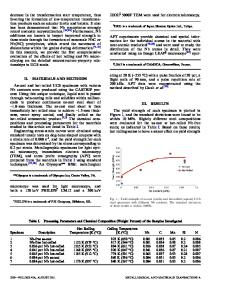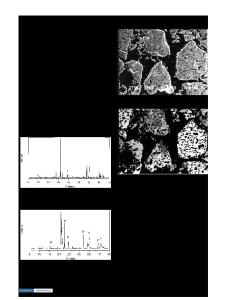The Effect of Nb Micro-alloying on the Bainitic Phase Transformation Under Strip Casting Conditions
- PDF / 1,145,518 Bytes
- 5 Pages / 593.972 x 792 pts Page_size
- 96 Downloads / 378 Views
rect strip casting is a method of producing steel sheet from liquid steel by casting it directly into thin sheet.[1] This process eliminates the need for reheating and hot rolling, and this leads to a significant energy saving when compared to conventional processing. For environmental reasons, it is anticipated that direct strip casting will become an increasingly common method of producing steel sheet. However, the strip casting process subjects the material to extremely high cooling rates, and this results in strip cast steels typically developing a mixed microstructure of Widmansta¨tten, martensitic, and bainitic ferrite morphologies, depending on the steel chemistry.[2-6] The effect of solute elements such as Nb is of particular importance in strip casting because the cooling rate during austenite decomposition is sufficiently high that precipitation of carbides and nitrides cannot occur,[3,7,8] and in the case of a typical high strength low alloy steel chemistry, Nb and C both exist in solid solution above equilibrium concentration. It therefore becomes imperative in this case to understand
N. STANFORD is with the Future Industry Institute, University of South Australia, Mawson Lakes, Australia. P. D. HODGSON and T. DORIN are with the Institute for Frontier Materials, Deakin University, Geelong, Australia. Contact e-mail: [email protected] Manuscript submitted July 20, 2018.
METALLURGICAL AND MATERIALS TRANSACTIONS A
the mechanism of the phase transformation under these conditions in order to guide future alloy and process design, with particular emphasis on the increased solute content and high cooling rates. High-strength low-alloy (HSLA) steels that are processed by strip casting form predominantly bainitic microstructures.[3] The bainitic transformation is well studied, e.g., References 9–12 and the effect of Nb has received some attention because of its industrial importance as an alloying element in HSLA steel grades.[3,6,13,14] Chen et al.[15,16] have recently shown that concentration spikes in Mn ahead of the interphase interface can retard bainitic growth rates, the so-called transformation stasis, and one would anticipate that Nb may have a similar effect. Indeed, the formations of polygonal ferrite[17] and ferrite formed by the massive transformation[18] have both been shown to suffer from solute drag as a consequence of Nb segregation at the austenite/ferrite interface. But will solute drag have any impact under strip casting conditions? Does this process require a more stringent control of steel chemistry than the conventional slab casting process? To examine these questions, three alloy compositions have been examined to determine explicitly what effect the addition of Nb will have on the microstructural development of low-alloy steels under strip casting conditions. Rather than simply reheating bar stock and examine the microstructure after continuous cooling, we have taken the more experimentally intense route of simulating the strip casting process from liquid through to room temperature. I
Data Loading...










